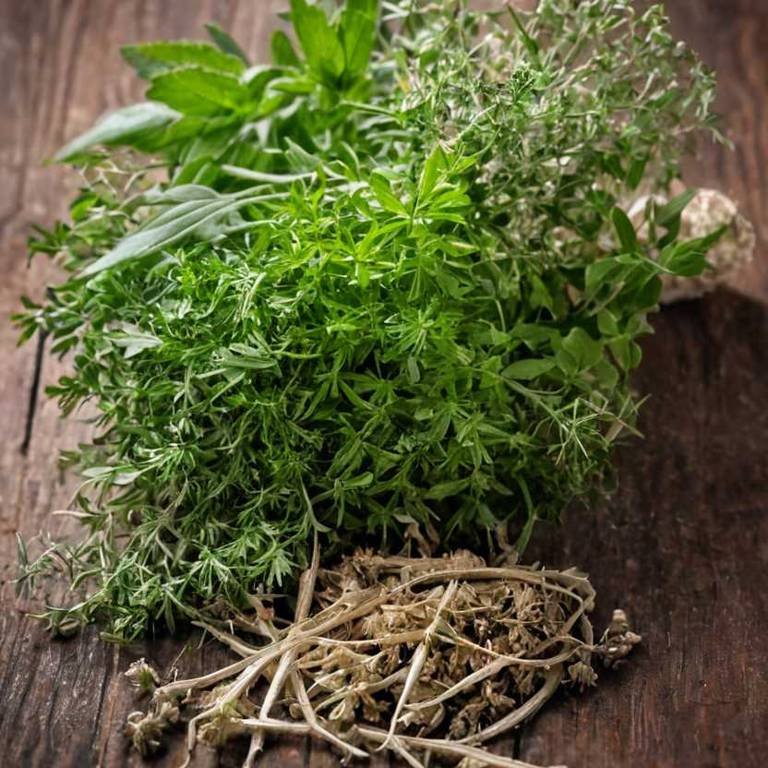By Leen Randell
Updated: Jul 07, 2024
What to know about Ambrosia arborescens (golden ragweed) before using it medicinally

Ambrosia arborescens, commonly known as golden ragweed, is a herb renowned for its remarkable health-promoting properties, including its ability to alleviate symptoms of allergies, digestive issues, and skin conditions, thereby enhancing overall well-being.
As a hardy perennial plant, it is often cultivated in temperate climates for its ornamental value, as well as its potential for natural pest control and soil enrichment. Botanically speaking, Ambrosia arborescens belongs to the Asteraceae family, with distinctive yellow flowers and a growth habit that can reach up to three feet in height.
The herb has been documented in traditional medicine for centuries, with references dating back to the indigenous cultures of the Americas, who valued it for its anti-inflammatory and antihistamine properties.
This article explains the medicinal, horticultural, botanical, and historical aspects of Ambrosia arborescens.
What are the medicinal properties of Ambrosia arborescens?
Ambrosia arborescens helps with digestive issues, inflammation, and respiratory problems. Its extracts have been used to treat conditions such as indigestion, bloating, and irritable bowel syndrome. It also exhibits anti-inflammatory properties.
The active constituents of Ambrosia arborescens include sesquiterpenes, flavonoids, and triterpenes. These compounds have been shown to exhibit anti-inflammatory, antimicrobial, and antioxidant activities. The sesquiterpenes, in particular, have been found to be responsible for the plant's medicinal properties.
The parts of the plant most used for medicinal purposes are the leaves and flowers. The leaves are typically harvested in the summer months and used fresh or dried for medicinal purposes. The flowers are also used to make infusions and decoctions.
Improper use of Ambrosia arborescens can cause allergic reactions, such as skin irritation and anaphylaxis. Ingestion of large quantities can also lead to gastrointestinal upset, including nausea, vomiting, and diarrhea. Caution should be exercised when using the plant, especially in individuals with known allergies.
Precautions when using Ambrosia arborescens medicinally include proper identification of the plant, correct dosage, and caution in individuals with allergies or underlying medical conditions. It is also essential to consult with a healthcare professional before using the plant for medicinal purposes, especially in conjunction with other medications.
What are the horticulural aspects of Ambrosia arborescens?
Ambrosia arborescens grow in well-drained soils and full sun. This perennial plant thrives in areas with warm temperatures and adequate moisture. It can tolerate dry conditions, but consistent moisture promotes healthy growth.
When planting, choose a location with good air circulation to prevent disease. Sow seeds 1/4 inch deep and 6-12 inches apart. Thin seedlings to 12-18 inches apart to allow for mature plant growth. Transplant seedlings in the spring or fall.
Golden ragweed is harvested for its leaves and flowers. Leaves are collected in early spring, before flowering begins. Flowers are harvested in late summer to early fall. Use scissors or a sharp knife to minimize damage. Harvest in the morning when plant sap is highest.
Pests such as aphids, whiteflies, and spider mites commonly affect Ambrosia arborescens. Diseases include powdery mildew, leaf spot, and root rot. Regularly inspect plants and treat infestations promptly. Maintain good sanitation and hygiene to prevent disease spread.
What are the botanical aspects of Ambrosia arborescens?
Ambrosia arborescens is a perennial herb that exhibits characteristic features such as its stout stem, simple alternate leaves, and small yellow flowers arranged in panicles. The plant has a woody base and a branching habit, reaching heights of up to 3.5 meters.
Ambrosia arborescens belongs to the Asteraceae family and is classified as a species within the Ambrosia genus. Its taxonomic classification is as follows: Kingdom: Plantae, Phylum: Angiospermophyta, Class: Magnoliopsida, Order: Asterales, Family: Asteraceae, Genus: Ambrosia, Species: A. arborescens. This plant is closely related to Ambrosia trifida and Ambrosia psilostachya.
Several variants of Ambrosia arborescens have been identified, including A. a. subsp. arborescens and A. a. subsp. multiflora. These variants exhibit minor differences in their morphological characteristics, such as leaf size and flower arrangement. They are generally considered to be synonymous with the nominate species.
Ambrosia arborescens is native to the southwestern United States, northern Mexico, and parts of Central America. Its geographical range extends from the Gulf Coast to the western Great Plains and from California to New Mexico. The plant grows in a variety of habitats, including dry woods and prairies.
The life cycle of Ambrosia arborescens begins with germination, typically occurring in the spring. The plant grows vegetatively throughout the summer, producing roots, stems, and leaves. In the fall, the plant begins to produce flowers, which are wind-pollinated and allow for seed production. Seeds mature in the fall and disperse in the winter, completing the plant's life cycle.
What are the historical aspects of Ambrosia arborescens?
Ambrosia arborescens is a plant native to the Mediterranean region. Historically, its parts were used to treat various ailments, including fever, rheumatism, and digestive issues, particularly in ancient Greece and Rome.
Mythological references to Ambrosia arborescens are found in Homer's "Iliad" and "Odyssey", where it is described as a food for the gods, ambrosia. In Greek and Roman mythology, the plant was associated with divine nourishment and eternal youth.
Symbolic meanings attributed to Ambrosia arborescens include strength, protection, and purification. In ancient rituals and ceremonies, its leaves and stems were used for medicinal and spiritual purposes, signifying its significance in early cultures.
Historical texts, such as Theophrastus' "Enquiry into Plants" (c. 300 BCE) and Pliny the Elder's "Naturalis Historia" (77 CE), provide detailed descriptions of the plant's appearance, habitats, and medicinal properties. These texts demonstrate the importance of Ambrosia arborescens in ancient natural history and pharmacology.
Ancient artifacts, such as ceramics and frescoes, depict Ambrosia arborescens in its natural habitats and in various settings, including temples and healing centers. These visual representations offer valuable insights into the plant's historical significance and its uses in ancient cultures.